Once you get to South Figaro, you can…

…skip right past it, as a matter of fact. For the moment, nothing in the city is mandatory; in fact, you don’t even need to stop there at all once you complete the cave linking the city to Figaro Castle (or at least its former resting spot in the desert). By why wouldn’t you? At this point in the game, South Figaro is simply a resting point where you can recover from the journey and stock up for the future. Plus, it’s conveniently located between the cave you’ve just completed and the caves you’re about to explore.
So while you can head on to the destination shown above, the layout of the world map shows that the game designers clearly want you to stop in and see what’s hopping in South Figaro.

And here’s the first thing that’s happening, aside from the obvious future party member who totally blows you off for now: The first proper equipment shop of the game. This is actually pretty weird. Most RPGs let you go shopping within minutes of initiating the story; in fact, a properly old-school RPG makes a trip to the store your first task once you finish talking to the king/mayor/regent/whatever; dude gives you a mission and a pittance of gold and lets you buy gear.
Not so in Final Fantasy VI. The starter gear each character entered the game with has served you in good stead until this point, and it’s only now that you’re moving on to more challenging scenarios that you need to upgrade your equipment. This actually makes good sense from a narrative standpoint; what kind of sad sack adventurer begins an epic quest with no gear whatsoever? Locke and Edgar had a sense that they were heading into action, and Terra was presumably kitted out by the Empire, so why would you need to blow cash right away on gear?
However, the downside of this is that you went to the shop in Figaro Castle — the only that sold only tools for Edgar — without knowing about some of the helpful iconography of FFVI‘s shopping interface. (Unless, of course, you stopped in the tutorial rooms outside Narshe… but that was a lot of information being firehosed at you, and it’s easy to forget or overlook small details until you see them in action.) So it’s not until here that you’ll probably appreciate one of FFVI’s nicest innovations: When you go shopping, you can see every party member and get a sense of not only who can equip a specific piece of gear, but whether or not it represents an upgrade.
When an item is compatible with a specific character, that character’s sprite raises his or her arms. The relative effectiveness of a new item is denoted with a small icon: A green arrow (pointing upward) means it’s an improvement, a red arrow (pointing downward) means it’s weaker than your current gear, an equal sign means it’s a wash, and an E means it’s already equipped. This is a simple, brilliant way of making transparent something that traditionally was a confusing, unintuitive mess in RPGs, and any post-FFVI that didn’t or doesn’t adopt a similar system deserves to be kicked in the pants.
This system isn’t perfect. The relative stat indicators are based on the item’s most fundamental stat — Attack Power for weapons, Defense Power for armor. It doesn’t account, for example, for a sword that boosts its user Magic Power stat, or for a breastplate that improves your Evasion stat. It’s always a good idea to do a granular comparison by item. Especially if you come to a new shop and find a weirdly expensive piece of gear that nevertheless has a red arrow icon. There’s probably some sort of special trait to it that doesn’t factor in to the icon calculations — a fact the game doesn’t really explain.
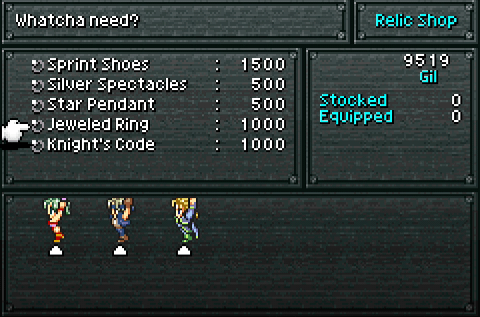
The other new kind of shop in South Figaro — and this is a doozy — is the Relic Shop. Let’s look at Relics, shall we?
Final Fantasy VI dispenses with the Job System of FFIII and FFV, but unlike FFIV it doesn’t lock your characters into a single, fixed class. Instead, it splits the difference; each party member has his or her own specific, assigned class, and that class comes with a set skill (Edgar’s Tool, Locke’s Steal, and Terra’s Magic — well, seemingly Magic for now, though sharp-eyed players may have noticed that Magic occupies a different action menu slot than the other heroes’ class skills). This never changes, even after many class skills have been rendered obsolete in the late game.
However, FFVI dives head-first into the idea of character customization through two different mechanics. One of those won’t become available until you’ve traveled a fair distance into the game, but other becomes properly available here: Relics.

Relics look like standard equipment, but there’s an entirely separate menu slot dedicated to equipping them. In other RPGs, these might be designated in the accessory slot, but while Relics do often confer the same sort of boosts and buffs that traditional RPG accessories do (a stat bonus here, a status immunity here) many Relics can completely change the nature of your character. In short, with the proper combination of Relics, you can effectively grant characters a subclass.
You get the first proper taste of that here. The Relics available in South Figaro mostly offer passive bonuses: Silver Spectacles prevent Blind status, Sprint Shoes allow you to move twice as quickly while exploring (moot in this remake, where you can sprint by default), and so forth. However, the Knight’s Code does something completely different; rather than buffing your stats, it instead gives you permanent “Cover” status.
Final Fantasy veterans would immediately recognize Cover as a trait of the Knight class, beginning with FFIII. Even Americans in the ’90s, who missed out on FFIII and FFV, would have known it: Cecil gained the ability once he became a Paladin in FFIV. By equipping a Knight’s Code, that character will always jump in to take a physical hit for any other character in critical status, preventing the critical character from dying while absorbing the damage with a defensive bonus. So, with a Knight’s Code, a character gains a key trait of a Knight, even if they can’t become a Knight in the literal Job sense.
A few plot points from South Figaro, you can potentially acquire a second relic called a Gauntlet, which allows a character to wield a weapon with two hands for extra attack power (though of course without the defensive and evasion perks of a shield, which can no longer be held in the off hand). By putting both a Knight’s Code and a Gauntlet on a single character, you’ve effectively created a Knight. It’s not the Job System, as you don’t level up your Relics through use, but it’s an attempt to provide a similar sort of flexibility.
While the game doesn’t explain the Job connection directly, it does once again trot out a Moogle to explain the mechanic so there’s no chance of you failing to understand this equipment’s importance.
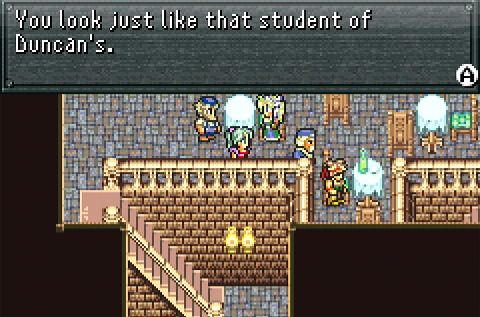
Besides capitalism, the other role South Figaro plays at this point is expository. You can wander through the (surprisingly large) town, chatting with citizens to get a sense of the world beyond the limited view you’ve seen so far. While much of it has to do with the omnipresent threat that the Empire poses, you also get some local color; apparently a martial artist named Duncan is a big deal.
It’s not clear from this dialogue box, but this is meant to be directed specifically at Edgar — a hint for an upcoming plot twist, though one that unfortunately makes sense only in hindsight.
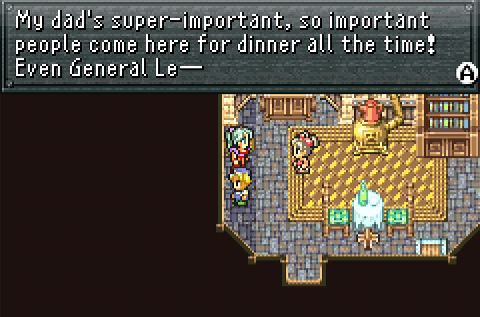
Mouthy kids giving away the big plot twist after that one.
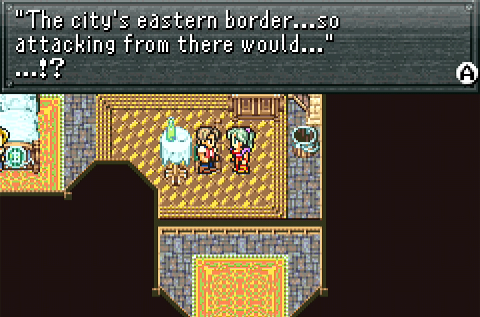
Clearly the citizens of South Figaro are all quite upstanding. This, as it happens, is a bit of eavesdropping you do in the home of the city’s richest man. Evidently simply being the wealthiest man in town isn’t enough for the guy and he’s trading state secrets. Or is it that he’s the wealthiest man because he’s trading state secrets?
In any case, Edgar seems oddly silent on what is clearly a matter of border security.
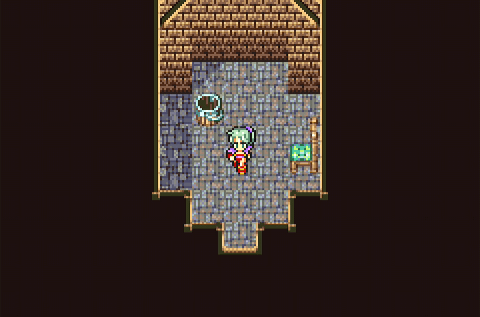
Although it’s currently optional, poking around through the streets, shops, and homes of South Figaro is the first chance you’ve had to really roam freely in FFVI. Everything up until now has been blocked off, locked away, or otherwise pushing you inexorably forward. Here is an entirely discretionary location filled with dozens of people with information and tips to relay; it’s a chance to dabble in some world-building, to establish some context for the adventure ahead.
You can also stumble across sights like the room above. It seems innocuous enough at first glance, but armed with hindsight of having experienced the game, a returning player knows the more ominous role this room will play. You’ll be revisiting South Figaro in the course of the game (and really, not too far out), and the fact that you can poke around in places that have a crucial story role while they’re still in a blank, neutral state is pretty cool. Usually games lock you out of plot-specific locations until they become relevant, or else the first time you visit a place is the only time it is relevant. FFVI‘s team put in a little extra effort to render this city in multiple states, and the game world is richer for it in a way that few people will even consciously notice.
> the game world is richer for it in a way that few people will even consciously notice.
I really appreciated this at the time; having persistent places in RPGs that change slightly, or are even neutral most of the time, makes the world feel more alive. It’s a relatively easy way to give a (at this point) fairly linear RPG a bit of an open world feel without the break-the-bank detail a real open world game would require.
There’s a narrative power to taking a familiar location and changing it in some significant way. (That’s why disaster movies tend to take place in New York or DC — you might not know what, say, downtown Phoenix looks like, but you’ve seen the Statue of Liberty and the Washington Monument even if you’ve never been to those places.)
FF6 takes the first place you’re free to explore and, shortly, turns it into an occupied zone under the Empire’s bootheel. (And then, of course, the entire last half of the game is about revisiting familiar locales that have been fundamentally altered by a crisis event.)
FF7 goes even less subtle; it takes the first place you’re free to explore, blows it up, kills most of the supporting cast that’s been established up to that point, and puts a steel girder through a playground.
It’s interesting to look at other games that alter familiar environments for atmospheric purposes — most Zelda and Metroid games do that, off the top of my head. FF5’s got the two worlds that get combined. Castlevania: Bloodlines wrecks that town from Simon’s Quest. Chrono Trigger’s built entirely about revisiting the same locations in different eras.
Hell, you spend a good big chunk of Dragon Quest 2 and 3 revisiting the first game’s setting.
RE: Sprint Shoes: While you don’t need them to move fast in the remakes, you can move even faster than in the original game if you equip a pair and hold the run button in said remakes. You don’t ever really need to move that fast, but it’s still an option.
Another thing about South Figaro most players might not notice is that it’s loaded with invisible spots outdoors that you can inspect with A to find many free items. They’re primarily just things you can buy at the item shop, but free loot’s free loot.
By the way, I saw this post before it was available on the main site via the Most Recent Comments widget on the side bar. I assume it was posted early for Patreon readers, so you may want to consider removing the widget… or tampering with it somehow, I’m not sure how it’s coded.
I found it via a link after the Meteos article linking to previous articles and didn’t realize it wasn’t already up until I checked the site proper earlier today. If it was intended only for early viewing or otherwise not to be seen before official release then something’s not working right.
True story - my RPG novice friend reached the Floating Continent having NEVER EQUIPPED ANYTHING. I blame this squarely on how long it takes to reach a shop.
I don’t think your friend was the only one. One thing I noticed playing through the SNES Final Fantasies for the first time was how many mechanics and segments in _Mario RPG_ felt like responses to failed mechanics in FFIV-VI.
Mario RPG doesn’t just tell you to equip your first weapon once (without a tutorial), but it will bring it up again ten minutes later in the Chancellor’s room if it notices you didn’t equip it on your own, this time offering a tutorial. Only then will it let you say “No, I am leaving it unequipped on PURPOSE.”